With Coastal Lowlands as well as beaches, lagoons, and forests west of the bay, the Ocean State of Rhode Island happens to be an excellent place for birding. Today we are going to explore some of the birding scene in Rhode island and we’ll give you some identification tips, feeding tips, and even advise you about some hotspots that you won’t want to miss. Let’s talk about the popular backyard birds of Rhode Island!
3 Categories – 431 Birds
As you might expect, with such a collection of lush, scenic environs, Rhode Island is a very attractive place for birds and people alike. You can find more than 431 Avian species here and while we can’t talk about all of them, we can give you a seasonal sampling to look for to get you started. We’ll divide them up like this:
- Year-round Resident birds
- Birds of Spring, Summer, and Early Fall
- Fall and Winter Birds
After we give you the season information we’ll tell you what to look for, where these birds like to spend their time, and throw in some feeding tips as well for luring them into your backyard. The rest, of course, is up to the birds!
Rhode Island’s Year-round Resident birds
These birds have made Rhode Island their year-round home and we can’t say that we blame them. With a bit of patience and some judicious feeder choices, you might just get a visit from one of the following year-round birds this year:
- American Robin
- American Goldfinch
- Gray Catbird
- Northern Cardinal
- Song Sparrow
American Robin – Turdus migratorius
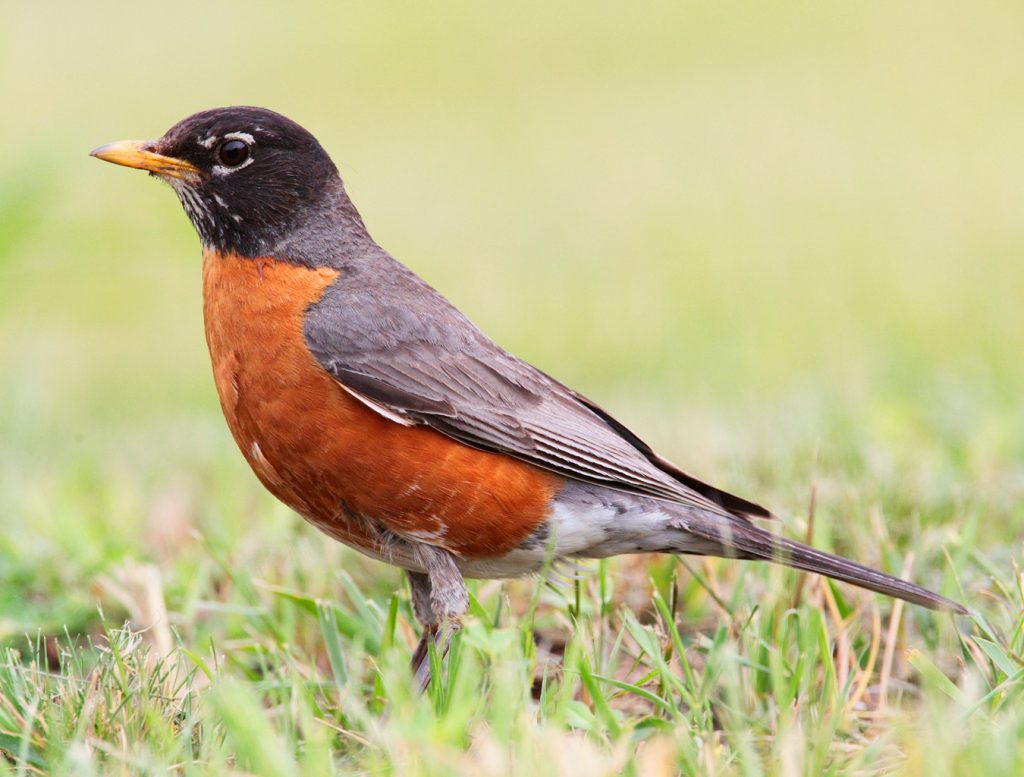
Coloration and Markings: American Robins have dark brownish-gray backs with long wings and long tails of the same color, though you will see some white on the undersides of the tail coming from the rump. The underbelly and breast of the Robin are a reddish-orange and facially, this bird has a black head. You will also notice an eyeline which looks as if it has been dropped, as ‘broken’ pieces of the circles surround the eyes. These birds have slightly-curved, medium-length yellow bills which sometimes have a touch of black at the tip. Females tend to be lighter in color and display considerably less contrast.
Size: These birds measure in at 7.9 – 11 inches in length and have wingspans of 12.2 to 15.8 inches wide.
Habitat: American Robins like deciduous woods but they are also fond of coniferous trees such as Pine. That said, they may be found in a number of environments and it’s not uncommon to see Robins in pastures, golf courses, backyards, or just hopping around in the snow. They are bold and hearty birds and so they get a round a bit.
Diet: Suet, peanuts, and any fruit that you have around can make for a happy, visiting Robin.
American Goldfinch – Spinus tristis

Coloration and Markings: Male American Goldfinches have bright yellow backs with lonh, black wings and short, notched tails. The wings will display 2 white wingbars on each wing and some assorted white markings towards the cent, while the tail will have white markings present as well as white on the underside coming from the rump. The underbelly and breast of this bird are bright yellow like it’s back and facially, this bird is bright yellow as well. Exceptions include the bird’s jaunty half-cap, ‘worn’ over the forehead, and a medium-length, conical orange bill. Females tend to have duller yellows and an olive back, underbelly, and breast, and in the winter both genders molt their warm-month colors and change into a dull brown with still-visible wingbars.
Size: These birds measure in at 4.3 – 5.1 inches in length and have wingspans of 7.5 to 8.7 inches wide.
Habitat: Finches love foraging in fields, especially in flood-prone areas, but they also range into many other environments so don’t be surprised if you see them on the side of road, in parks, orchards, or backyards with well-stocked feeders.
Diet: Nyjer thistle and hulled Black Oil Sunflower seeds are favorites of the American Goldfinch and can keep them coming back for more.
Gray Catbird – Dumetella carolinensis

Coloration and Markings: Gray Catbirds are a stone-gray color on their backs, their broad, medium-length wings, and their long, gray tails. These tails display a foxy-brown mark close to the rump and the remaining underside of the feathers will be black with some gray highlights. The underbelly, breast, and face of this bird will be stone-gray as well but you will see a touch of black just in front of the eyes and a small, black cap as well. These birds have medium-length, straight black bills, with a minute curvature present as the upper bill.
Size: These birds measure in at 8.3 – 9.4 inches in length and have wingspans of 8.7 to 11.8 inches in width.
Habitat: These are birds or brushs, brambles, thickets, and thorns. Catbirds are especially fond of brushy areas close to streams and also spend a lot of time in fields and at the forest’s edge.
Diet: Blueberries, Raisins, and Grape jelly are all treats that you can use to lure a Catbird in for a closer look.
Northern Cardinal – Cardinalis cardinalis
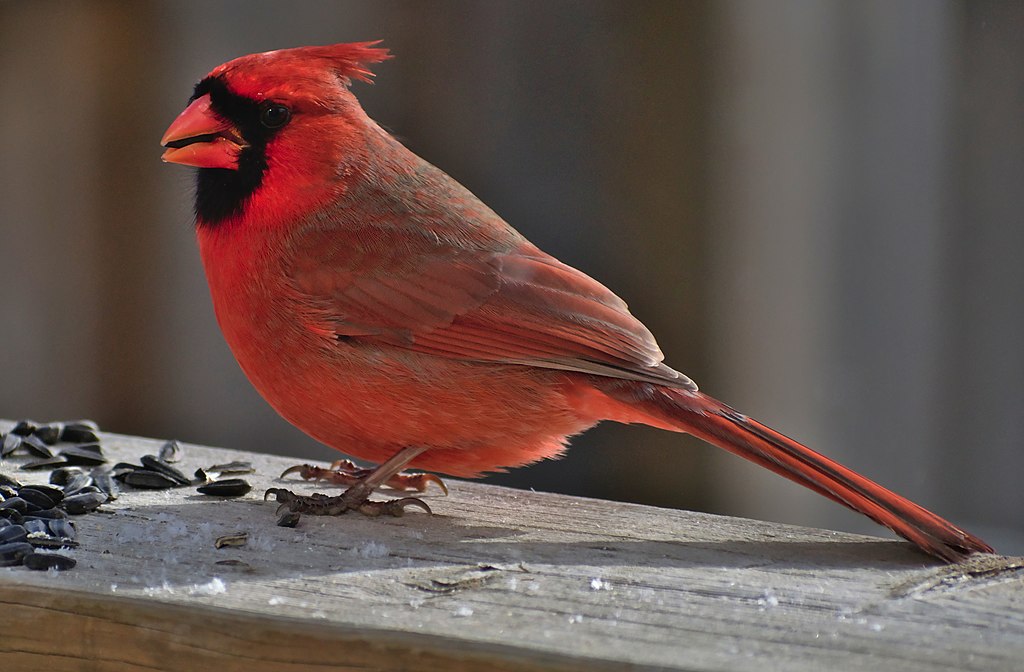
Coloration and Markings: Northern Cardinals have breathtaking plumage, with the males being completely red (though you may see some gray when they are molting). They have medium-length wings and long tails and facially, this bird has a beautiful red crest and a mask that goes from the eyes to carry down and display angularly underneath the short, stout, reddish-orange bill. Females will have the same look but a soft, brown plumage, with tinges of red throughout.
Size: These birds measure in at 8.3 – 9.1 inches in length and have wingspans of 9.8 to 12.2 inches wide.
Habitat: Cardinals love shrub and brush cover and tend to be found in residential areas, where you can see them in woodlots, parks, golf courses, and backyards with well-stocked feeders.
Diet: Black Oil Sunflower seeds, wheat, rolled oats, and whatever sweet fruits that you have on hand can tempt and possibly keep the attentions of the stunning Northern Cardinal.
Song Sparrow – Melospiza melodia
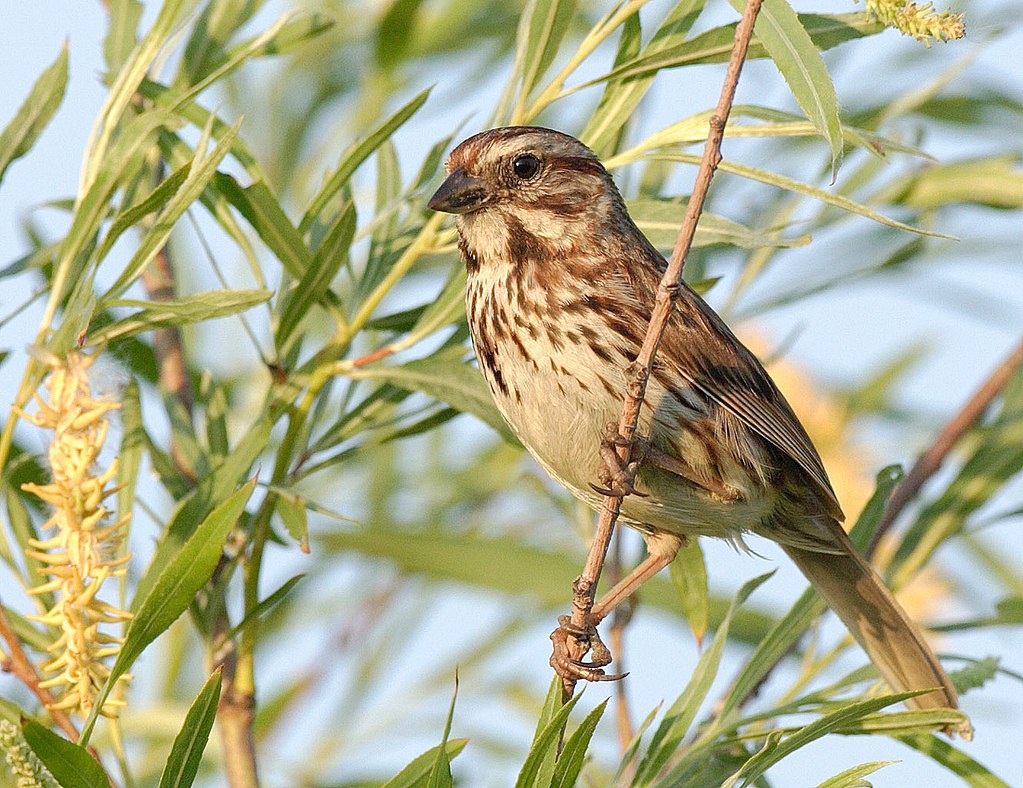
Coloration and Markings: Song Sparrows have soft, gray backs with warm, brown streaking present. They have broad, medium-length wings which are streaked brown and gray-tipped and long, brown tails with some grays present. The underbelly and breast of this bird are gray with brown streaking and facially, this bird has a gray face with a white mustache line, over and underlined with brown, and a brown eyestripe as well as a brown cap. This bird has a small, stout, and conical gray bill.
Size: These birds measure in at 4.7 0 6.7 inches in length and have wingspans of 7.1 to 9.4 inches wide.
Habitat: These birds love open areas, especially near water, so look for them in weedy fields, the forest’s edge, or close to ponds or marshes. They do range out into residential areas quite often, looking for well-stocked feeders.
Diet: These birds like seeds, grains, and berries, so try a mix of Nyjer thistle, wheat, rolled oats, and some dried or fresh Blueberries for dessert.
Rhode Island’s Birds of Spring, Summer, and Early Fall
When the Daffodils and Crocuses start to show themselves again and the Ospreys are returning then spring has officially arrived in the Ocean state. From here and through the next few months there are a number of birds that will be arriving to enjoy the sweet Rhode Island spring and summer and many won’t leave until well into fall. See if you can spot one of these birds during the warmer months:
- Barn Swallow
- Blue Jay
- House Finch
- Rusty Blackbird
- Palm Warbler
Barn Swallow – Hirundo rustica
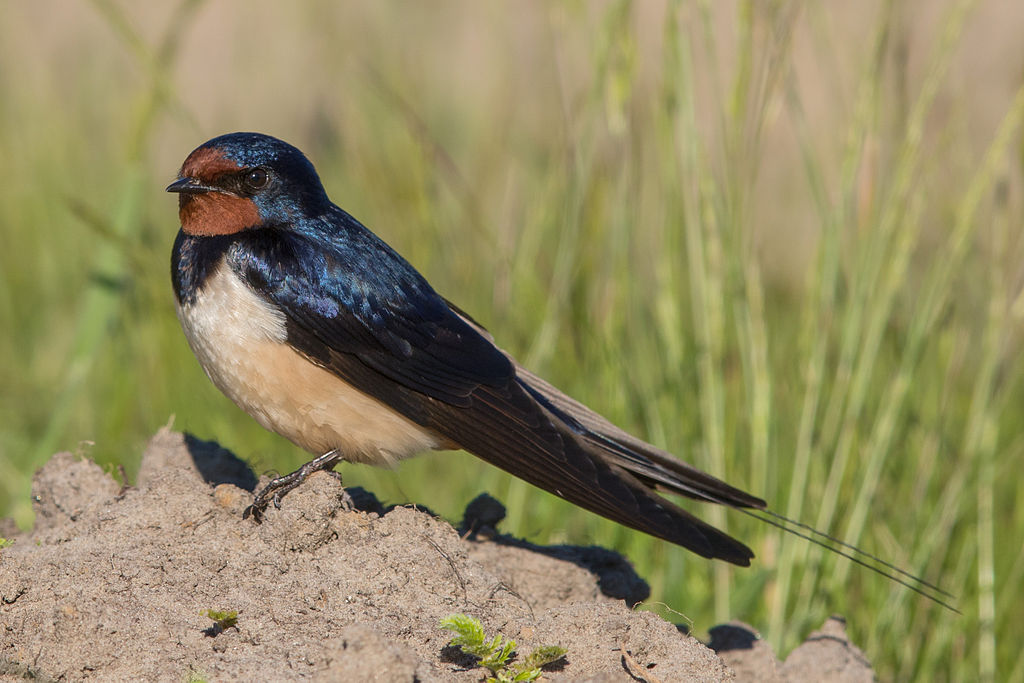
Coloration and Markings: Barn Swallows are the superheroes of the bird world. They have deep blue backs as well as long wings and tails which are short but have extended wingtips on either side so that the tail is forked. The underbelly and breast of this bird are orange to reddish orange, with some minute white tufts around the edges, and at the breast you can see 2 ‘strap marks’ that look as if the blue wings and tail are a cape which the bird is wearing. The reddish-orange color is deeper between these ‘straps’ and this color extends up into the lower face. Facially, the orange colors the lower half, including the chin and framing the underside of the cheeks, then triangulating in the center to terminate just above the bill. The upper half of the bird’s face is deep, dark blue with a diamond-shaped black mask and a short, triangular black bill.
Size: These birds measure in at 5.9 – 7.5 inches in length and have wingspans of approximately 11.4 to 12.6 inches wide.
Habitat: These superbirds may be found in many places, such as meadows, clearings, streams, marshes, and small buildings. As the name suggests they like to nest and forage around human habitations but when that’s not possible even a remote bridge will do.
Diet: These birds primarily eat insects, so your best bet for luring them will be dried mealworms and crickets or simply live mealworms.
Blue Jay – Cyanocitta cristata
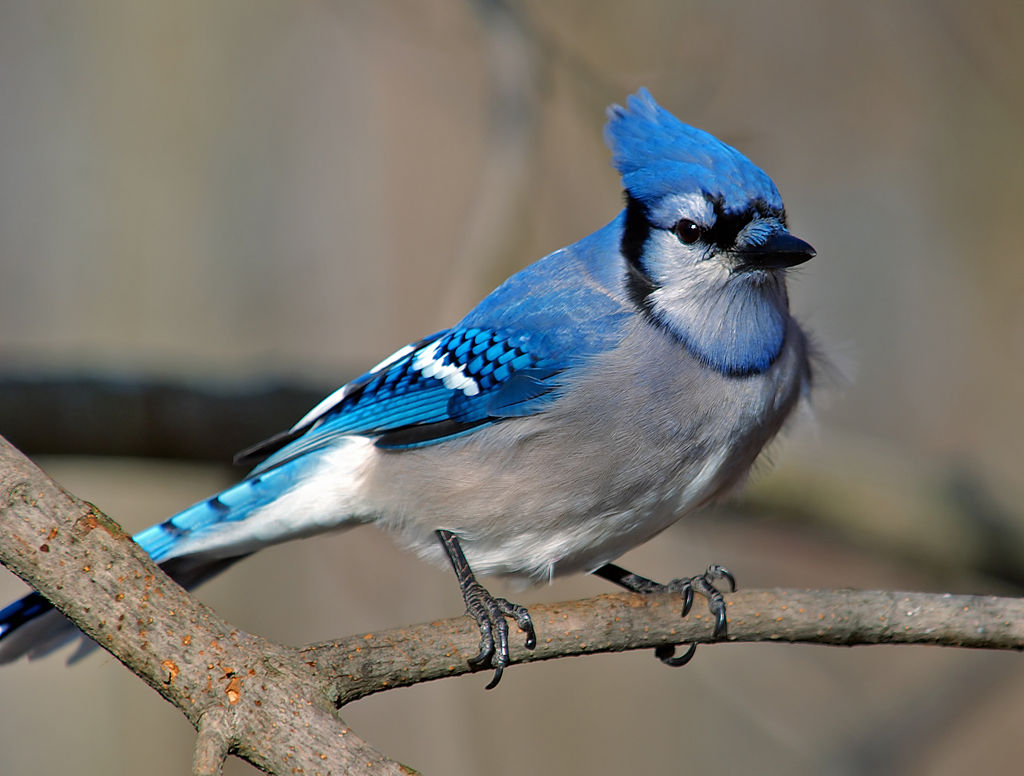
Coloration and Markings: Blue Jays have deep sapphire blue backs, with long, blue wings and long tails with white outer feathers. The wings have a scaling pattern of blue outlined in black color just below the shoulders, as well as a large, white wingbar, and large white spots outlined in black below. The tails have a bit more symmetrical look to them, with squares of light blue outlined in darker blue going down the length and white on the undersides. The underbelly and breast of this bird are snowy-white and this color carries up into the face, briefly interrupted by a black line travelling from the termination of the bird’s lovely light-blue crest and down to circle the throat. Facially, aside from the brilliant crest this bird is completely white except for a long, thick, and straight black bill.
Size: These are good-sized birds, measuring in at 9.8 – 11.8 inches in length and having wingspans of 13.4 to 16.9 inches.
Habitat: These birds love open areas, such as the forest’s edge, meadows, and clearings, especially if there are Oak trees nearby. They love to smash the acorns and eat them, so near any Oaks you might just spot a Blue Jay. They are also no strangers to the suburbs, where you can find them in parks or perched on a fence of phone line, and they also visit backyard feeders if you have left a little something out for them.
Diet: Peanuts and Black Oil Sunflower seeds are favorites of this bird, but you can even attract them by the simple presence of a birdbath – which Blue Jays absolutely love.
House Finch – Haemorhous mexicanus
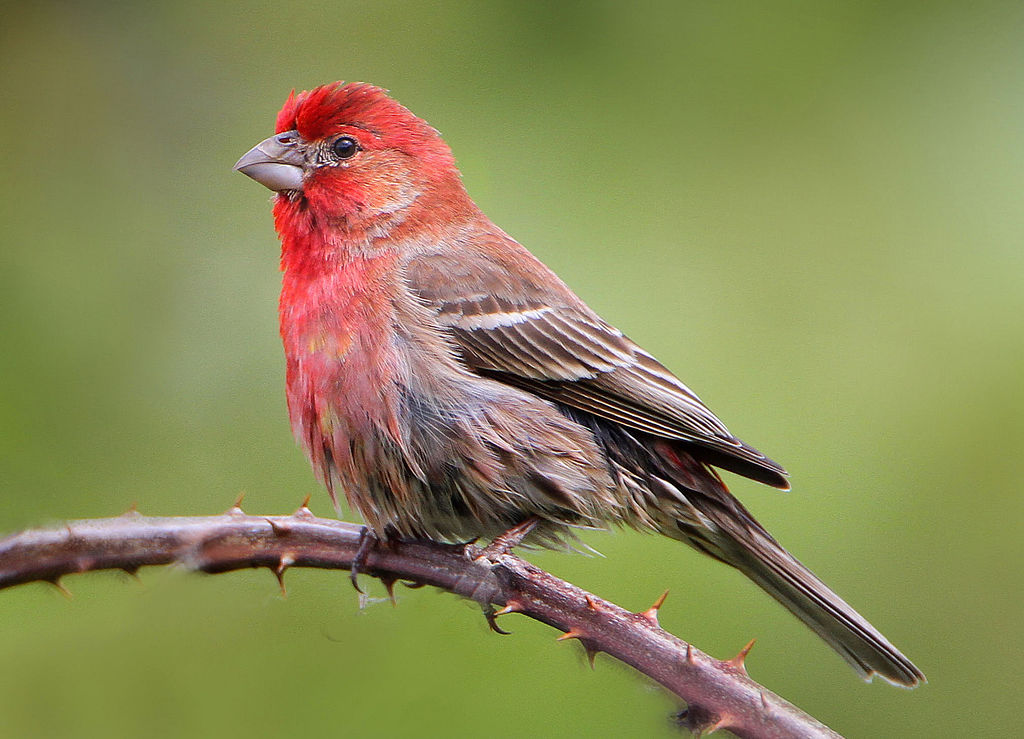
Coloration and Markings: Male House Finches have grayish backs with dark brown streaks, with small wings and medium-length tails of the same color. The wings will exhibit 2 white wingbars each and you will see white on the outer feathers on the tail. The underbelly of this bird is white with brown streaking but with small amounts of rosy-red which greatly increase and take up the breast. Facially, this bird has a red throat and forehead, with the remainder of the face being gray with the exception of a grayish-brown eyeline which goes through the eyes and curls around to frame the cheek. These birds have short, thick silver bills with a visible curve on the upper bill. Females will lack the red and the facial markings and their streaking on the undersides will be a bit blurry, with a grayish brown color being present over most of the body.
Size: These birds measure in at 5.5 – 5.5 inches in length and have wingspans of 7.9 to 9.8 inches wide.
Habitat: In the wild you can spot these birds in overgrown, weedy fields, open woods, and even deserts. They are quite urbanized as well, visiting parks, farms, and residential backyard feeders as well.
Diet: White Proso millet and Nyjer thistle are two favorites of the House Finch. Mixed or separate these are an excellent lure that these birds will munch up happily.
Rusty Blackbird – Euphagus carolinus

Coloration and Markings: Male Rusty Blackbirds can be hard to identify in the warmer months, when they are completely black, but there are a few things to look for. Look for black, rather than black and blue at the edges of the wings and around the eyes. These birds have medium-length wings and long tails and in the winter months, they will have rusty color at the back, shoulders, underbelly, and breast as well as the sides of the tail. Facially, they are rust colored as well with a black mask present. These birds have white eyes and long, straight black bills. Females will be brown with some ‘rust’ around the edges and a whitish eyebrow line.
Size: These birds measure in at 8.3 – 9.8 inches from head to tail and have wingspans of approximately 14.6 inches wide.
Habitat: These birds are almost always found around water, so look for them around bogs, marshes, streams, and ponds. Areas prone to flooding such as overgrown, disused fields can also harbor Rusty Blackbirds as well.
Diet: These birds are unlikely to visit your feeder, unless perhaps you have live mealworms. In the wild they eat insects, crustaceans, fish, and even smaller birds!
Palm Warbler – Setophaga palmarum

Coloration and Markings: Palm Warblers have olive-brown backs with short wings and medium-length, perky tails of the same color. The underbelly and breast of this bird will vary, with eastern birds having yellow, brown streaked coloration while the western warblers will be white with brown streaks. Facially, these birds have olive color on their face but will exhibit yellow or white streaked chins and a large eyebrow line of yellow or white, which turns a tan color at the last 1/3 going towards the back of the head. This bird has a brown and cinnamon cap and a long, pointy, straight brown or brown and yellow bill. The cap is at its most colorful during the warmer, breeding months but dulls in color after mating season terminates.
Size: These diminutive beauties measure in at 4.7 – 5.5 inches in length and have wingspans of 7.9 to 8.3 inches wide.
Habitat: These birds like open areas, such as the forest’s edge, meadows, and fields, and may be found just about anywhere if there are a few trees and some shrub cover. They favor boreal forests for breeding but they do range out and visit backyards on occasion, provided that the feeders are well-stocked enough to get their attentions.
Diet: These birds eat insects primarily, however, they like to supplement their diet with berries. Try leaving out some whole Blueberries or Chopped cherries and live mealworms if you’ve got them.
Rhode Island’s Fall and Winter Birds
With lows averaging around 40 degrees Fahrenheit, you’ll definitely want to have your coat for a Rhode Island winter. Despite the chill, a number of rough and tumble birds are still going to be out there, foraging and frolicking, and you should let them know that you care. Leave out something to up the following birds from the inside this winter, they’ll be much-obliged:
- Dark-eyed Junco
- Tufted Titmouse
- White-throated Sparrow
- Red-breasted Nuthatch
- Snow Bunting
Dark-eyed Junco – Junco hyemalis

Coloration and Markings: Dark-eyed Juncos are most commonly dark brown or gray, with medium-length wings and long tails. The tails will be white and gray tipped on the undersides and the underbelly and breast of this bird are white, but with a flanking of gray or dark brown on the sides that increases in density as the color enters the breast. Facially, these birds are gray or dark brown, with stout, medium-length, conical pink bills with a minute trace of black under the bill and a small amount in front of the eyes. When viewed at rest, the white undersides often look to be evenly white as if the bird was quickly dipped in paint.
Size: These birds measure in at 5.5 – 6.3 inches in overall length and have wingspans of 7.1 to 9.8 inches wide.
Habitat: In the warmer months these birds are found in coniferous and mixed-coniferous woods and while they still range out during this time, they leave the woods with more frequency during the winter. At this time they are quite often found in fields, parks, and backyards where feeders have been stocked up in anticipation of their arrival.
Diet: White Proso millet, wheat, rolled oats, and cracked corn are all favorites of the Dark-eyed Junco but be sure to use a ground feeder, spreading a little grain and seed at the base to help to get their attentions.
Tufted Titmouse – Baeolophus bicolor
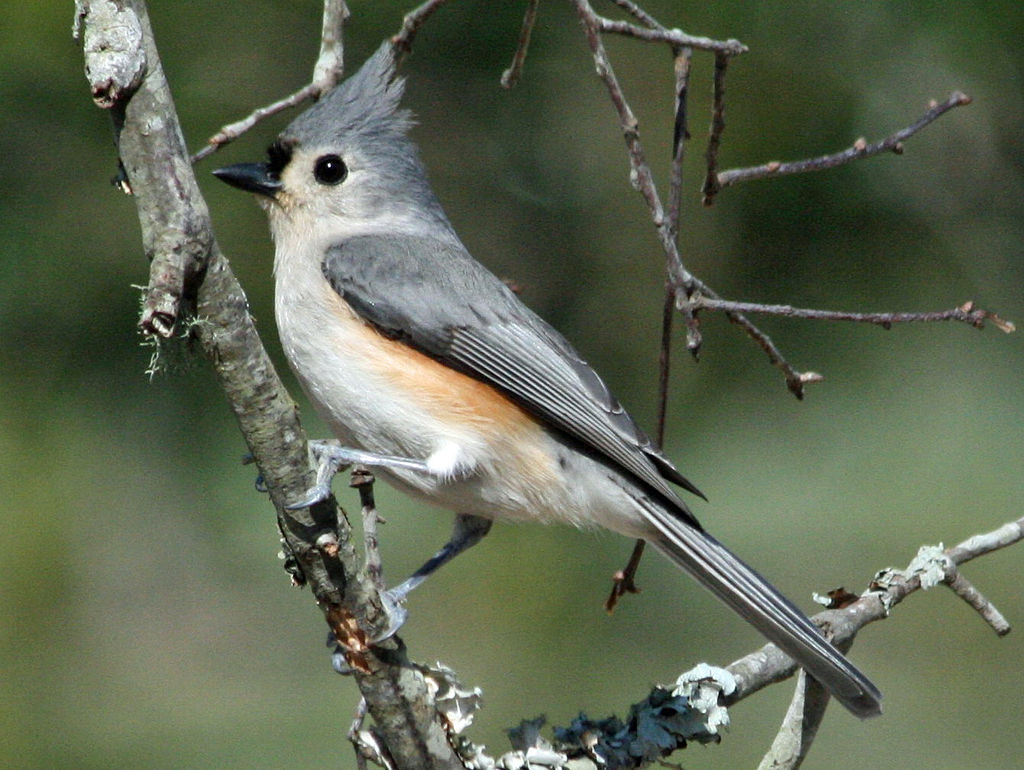
Coloration and Markings: Tufted Titmice have soft, grayish-blue backs with medium-length wings and long tails of the same color. They have a white underbelly and breast, with a faint splash of peach color underneath the wings, and facially these birds are white with the exceptions of their tiny, beautiful blue crests, which bring a little blue down to frame the eyes from the back and color the back of the neck as well. These birds have small, stout black bills with a noticeable curve on the upper bill and a distinctive black spot just above.
Size: These little guys and gals measure in at 5.5 – 6.3 inches from head to tail and have wingspans of 7.9 to 10.2 inches.
Habitat: These birds fancy Evergreen forests and deciduous woodlands but are frequent visitors to parks, orchards, and backyard feeders as well.
Diet: Suet, Striped Sunflower, Nyjer thistle, and crushed peanuts are a great way to attract and keep the attention of Tufted Titmice.
White-throated Sparrow – Zonotrichia albicollis
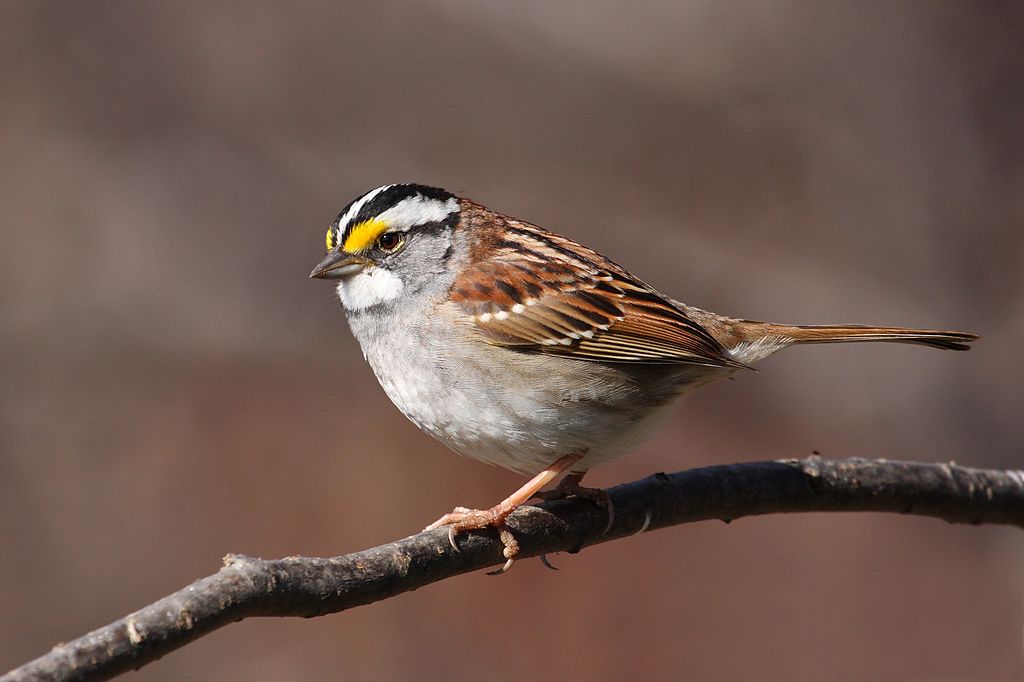
Coloration and Markings: White-throated Sparrows have brown backs and medium-length brown wings, with long brown tails as well. Two thin, white wingbars are present on each wing if you look closely and some white edging may be seen at the tail. The underbelly and breast od this bird are white with brown flanking present underneath the wings up until just below the shoulders and towards the top of the breast there is a V of gray color coming down from the face. Facially, these birds have grey under the eyes and at the cheeks, with brown at the back of the head, and a white chin and upper portion of the throat as well as a large, white eyebrow with a spot of yellow close to the bill. This bird also wears a distinctive ‘skunk cap’, with a white stripe running down the top and center of the head flanked by black stripes below. One variety of White-throated sparrow that is known as ‘tan striped’ which will have tan and brown instead of the black and white.
Size: These birds measure in at 6.3 – 7.1 inches in length and have wingspans of 7.9 to 9.1 inches wide.
Habitat: These birds like the forest’s edge and are often attracted to areas cultivated for wood as well. They are fond of shrub and brush cover and especially areas with water and when they range out, most frequently in winter, you can find them anywhere that there is some shrub cover and at least 2 or 3 trees.
Diet: These birds like White Proso millet and Black Oil Sunflower seeds and you can increase your chances of a feeder visit by providing them with a little cover, by way of assembling a brush pile for your feathered guest.
Red-breasted Nuthatch – Sitta canadensis
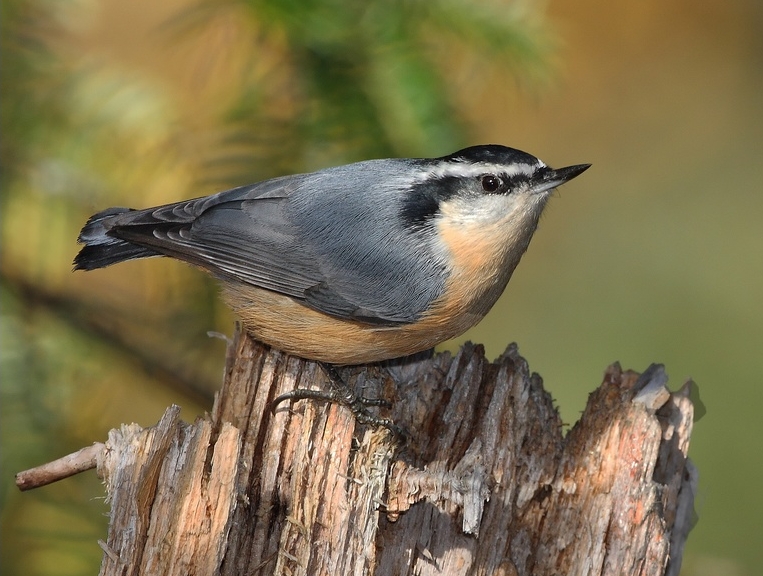
Coloration and Markings: Red-breasted Nuthatches have blue-gray backs with long wings and short blue-gray tails. The birds rump will be have a cinnamon spot as well as a blue-gray spot and the underbelly and breast of this bird will be a mix of white and cinnamon. Facially, these birds are white, with a black eyestripe that curves slightly and terminates at the back of the neck and this bird also has a black cap with a long, straight bill that is typically black on top with some whitish color below. You will notice that the lower bill has a light upward curve to it, as if the Nuthatch were a bit snobbish.
Size: These little birds average about 4.3 inches from head to tail and have wingspans of just 7.1 to 7.9 inches wide.
Habitat: These birds love the mountains and coniferous forests are their favorite habitat. They also frequent coniferous areas as well and occasionally range out to visit well-stocked backyard feeders.
Diet: Suet and crunchy peanut butter (which you can mix together for a treat!) are a great way to attract the attentions of the Red-breasted Nutchatch.
Snow Bunting – Plectrophenax nivalis

Coloration and Markings: Plumage varies a bit with Snow Buntings, but males during breeding season will generally be mostly white, with black backs and long, white, and black-patched wings and medium-length black and white tails. The inner wing will be white, as well as the underbelly and breast, and facially the bird is white as well except for its small, conical, black or orange bill. Females during breeding season will be mostly white but with brown streaking on their back and dirty-white on the face. When it’s not breeding season, males exhibit a rusty cap, with a rusty mark at the cheek, and another by the shoulder, while females will be rusty colored at the breast and on the face.
Size: These birds measure about 5.9 inches from tip to tail on average, with wingspans of approximately 11.8 inches in overall width.
Habitat: These are tundra birds and they like to frequent areas such as overgrown fields and other places of dense vegetation, especially when there is water close. Look for them around shore debris when you are visiting the coast as this is where you may most frequently spot them.
Diet: White Proso millet and hulled Black Oil Sunflower seeds may tempt these birds, but use a ground feeder and sprinkle a bit around the edges. It is uncommon for them to visit feeders, however, so keep your fingers crossed and you might get lucky.
Supporting cast (Other Backyard Birds of Rhode Island that might pay you a visit)
We like to include an extra section of year-round birds that you can look for in each one of our articles and we refer to these feathered wonders as our ‘Supporting cast’ birds. While they don’t get that primo spot at the beginning of the article, these beautiful birds are well worth keeping an eye out for throughout the year. See how many of these Supporting cast birds you can spot:
- Black-capped Chickadee
- European Starling
- White-breasted Nuthatch
- Mourning Dove
- House Sparrow
Black-capped Chickadee – Poecile atricapillus
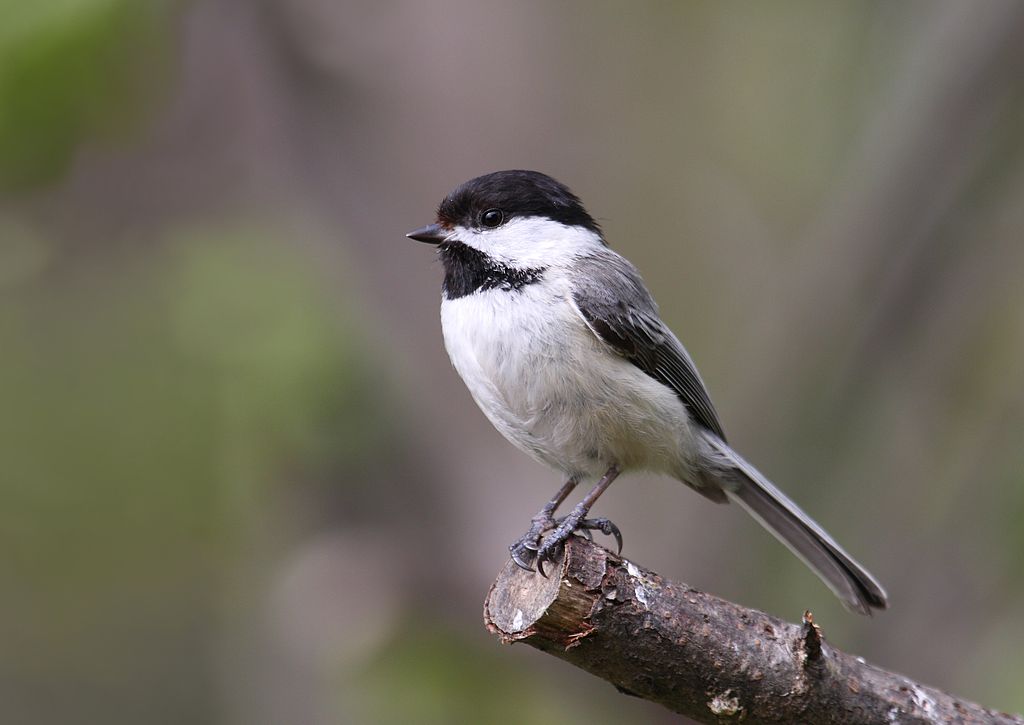
Coloration and Markings: Black-capped Chickadees have velvety gray backs with short, white-edged gray wings and long, thin and white-edged tails with black and white on the undersides. The underbelly and breast of this bird are white, with some tan flanking dimly present on the sides and facially, this bird has a small, black bib and a large, black cap, which settles down the head to terminate at mid-eye level, with white space taking up the middle of the face below the cap. These birds have tiny, conical black bills.
Size: These little cuties measure in at 4.7 – 5.9 inches in length and have wingspans of 6.3 to 8.3 inches wide.
Habitat: These birds like any place with dense vegetation for cover, especially so if there are a few trees nearby. You can spot them in cattail marshes, weedy fields, and they are frequent visitors to parks and backyard feeders as well.
Diet: Black Oil Sunflower seed is all that you need to get the attentions of the Black-capped Chickadee.
European Starling – Sturnus vulgaris
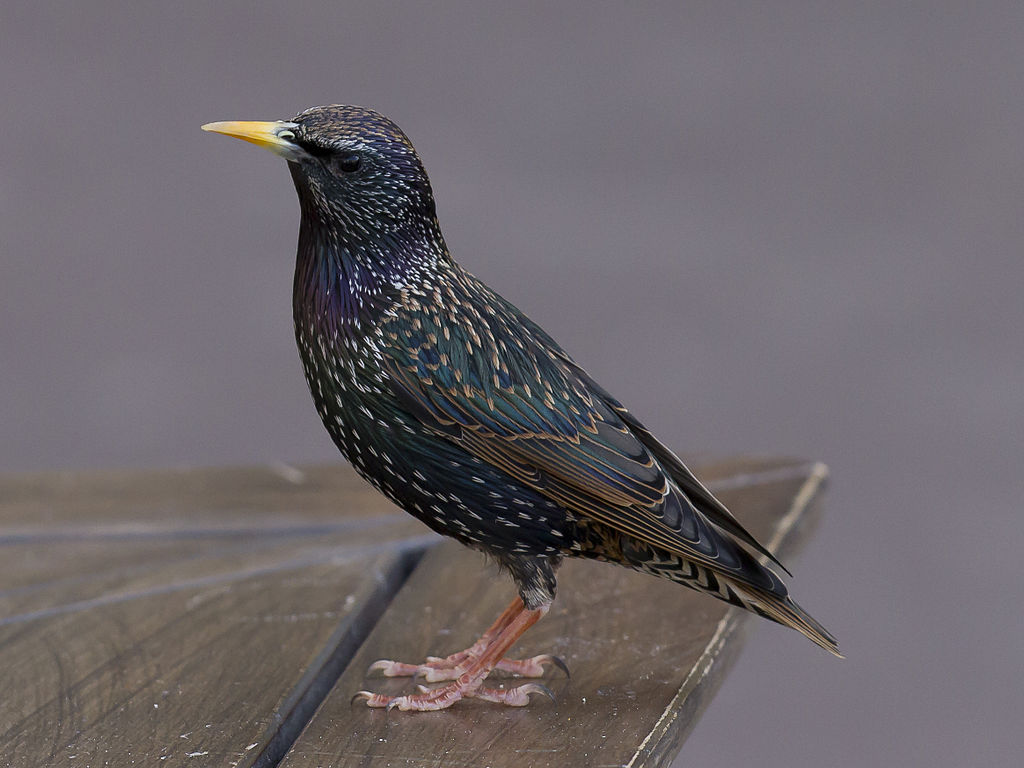
Coloration and Markings: From a distance a European Starling simply looks like a yellow-billed Blackbird, but up close you can see that the bird is completely covered with a purple and green sheen of plumage. They have short, pointed wings and short tails and their bills are long, straight, and yellow. In the winter, they make a dramatic transformation into brown plumage which is covered in beautiful white spots.
Size: Roughly Robin-sized, these birds measure in at 7.9 – 9.1 inches in length and have wingspans of 12.2 to 15.8 inches in width.
Habitat: These birds like to be around inhabited areas, so you won’t find them in the woods often, but rather at feeding lots in farms or around the city as they scope out snacks.
Diet: These birds will eat Black Oil Sunflower and Nyjer thistle seeds, though they really LOVE suet, so much that you might want to consider a Starling-proof suet feeder if they aren’t leaving any for the other birds.
White-breasted Nuthatch – Sitta carolinensis

Coloration and Markings: White-breasted Nuthatches have bluish gray backs with long, gray wings and very short, gray tails, with some black feathers and edging within both. The underbelly of this bird is white and there is a rust colored mark visible close to the rump. Facially, this bird is white, with the exceptions of a black line going diagonally at a low angle from the back of the bird’s eye and a lonh, black cap that goes to the nape of the neck and halfway to the shoulders. This bird has a long, straight, and stout black and silver bill.
Size: This bird measures in at 5.1 – 5.5 inches in length and has a wingspan of 7.9 to 10.6 inches wide.
Habitat: These birds love older woods, where they are frequent visitors to deciduous stands. They may be found in coniferous woods but this is with much less frequency.
Diet: Suet and crunchy peanut butter are a winning combination that can potentially lure the White-breasted Nuthatch in for a visit to your backyard feeders.
Mourning Dove – Zenaida macroura
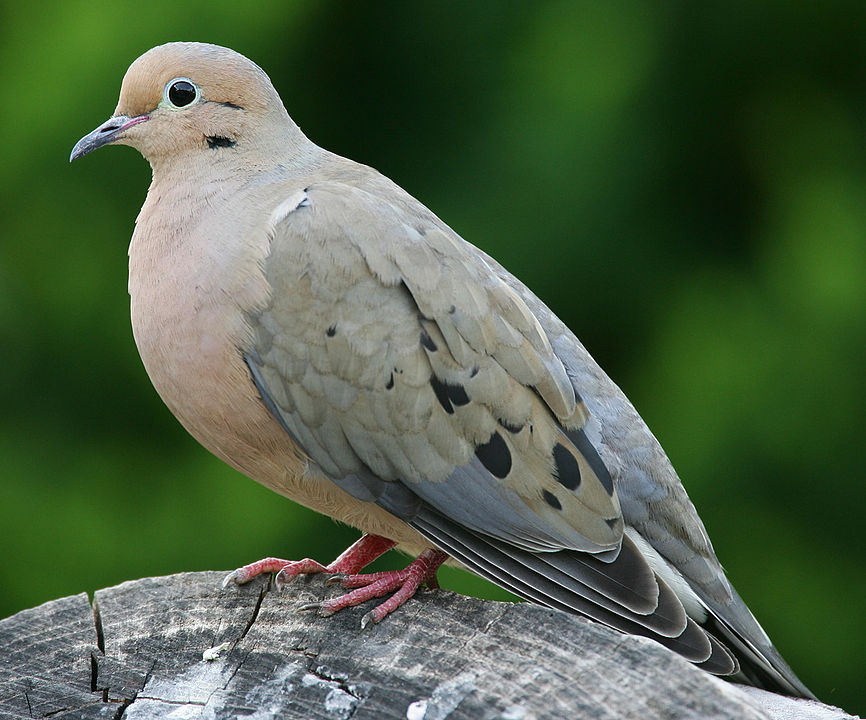
Coloration and Markings: Mourning Doves have gray backs with large, gray wings suffused with a buffy-tan coloration, especially towards their centers. This helps to highlight the large, black spots that further help to identify this bird and it also sports a long, thin, and somewhat pointy tail. The underbelly and breast of this bird are a base-white mixed with a heavy dose of creamy tan coloration which is also present in the face. This brings out the white eyering and a straight, medium-length, black bill finalizes the identification of your Mourning Dove sighting.
Size: These birds measure in at 9.1 – 13.4 inches in length and have wingspans of approximately 17.7 inches in width.
Habitat: These birds don’t even like the deep woods, prefer large, open, and even bare areas of ground. Barring these, fields are fine and these birds are quite comfortable in the city, waddling down the sidewalk with confidence even though people are nearby.
Diet: Black Oil Sunflower seeds, White Proso millet, and cracked corn are all favorites of the Mourning Dove.
House Sparrow – Passer domesticus

Coloration and Markings: House Sparrows have rich brown backs with black streaking present as well as medium-length wings and short tails displaying the same coloration, though the undersides of the tails will be gray mixed with brown. The rump of this bird is grayish-brown and the underbelly and breast will be a dirty grayish-white color, with a heavy dose of black in the upper breast coming down from the bird’s black bib. Facially, aside from the bib, there is a little black in front of the bird’s eyes, but behind the eye is a large, brown stripe that curls down and around to frame the cheek. The cheek and the neck will be white and this bird has a gray cap. Hous3e Sparrows have short, stout, and conical black bills.
Size: These birds measure in at 5.9 – 6.7 inches from tip to tail and have wingspans of 7.5 to 9.8 inches.
Habitat: These birds like to be around people. You can spot them in farms but this is as close as they get to nature and you are more likely to see them in cities, especially in places where they can snack easily like zoos, parks, arboretums, and backyards.
Diet: Cracked corn and any type of Sunflower seeds are a welcome feast to the House Sparrow.
Rhode Island Bird Buffet
When you want that perfect bird buffet to attract a diverse collection of birds it is nice to know that there is some good advice out there. Today we are sharing a little from the Providence Journal as well as some advice of our own that can help you to concoct that perfect combination to attract the birds that you want to see. You can read their full article through the link in our references and in the meantime, here are some foods to try:
- Black Oil Sunflower
- Nyjer thistle
- Suet
- Peanuts
- Cole’s Blue Ribbon (a mix of Black Oil Sunflower seeds and meats, cracked corn, and White Proso millet)
- Grape jelly
Rhode Island Birding Hot spots
The Chirparazzi have some tips for places in Rhode Island where you can go to see the winged celebrities we love in their natural element. Try visiting one of these locations when you have a little time to yourself and feel like a good ool’ dose of Nature:
- Northern hotspot – Stillwater Scenic Walkway
- Eastern hotspot – Manomet/Plymouth/Duxbury/Daniel Webster Wildlife Sanctuary
- Southern hotspot – William C. O’Neill Bike Path
- Western hotspot – Quabbin Reservoir
- Central hotspot – West Warwick Riverwalk
Detailed descriptions of each location as well as information regarding visiting and what birds you can see at these locations may be found at https://www.traillink.com/stateactivity/ri-birding-trails/ or at https://www.audubon.org/news/birding-rhode-island
In Closing
Today we have explored the wonderful world of birding in Rhode Island. While we are only able to scratch the surface in the space that we have we hope that you will take advantage of the tips which we have provided and maybe make a few new backyard friends. Until next time, keep an eye out and your camera ready, so that you can share a glimpse of the lovely scenery and the winged wonders that go with Rhode Island Birding!
